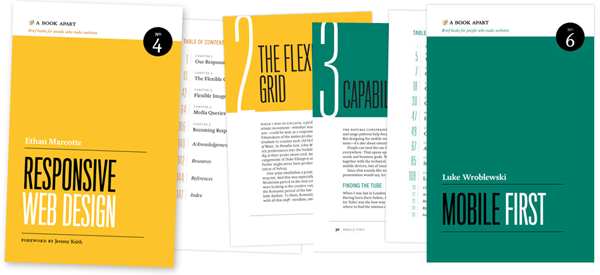Everything Apple Needs to Introduce at WWDC
With WWDC just a few weeks away, I thought it’d be beneficial to the Internet at large to compile a working list of everything that is expected of Apple during their Keynote and subsequent “State of the Union” addresses in order to appease the Internet. Failure to introduce each and every one of these features and updates will result in another stock price plummet, calls for Tim Cook’s ouster and an infinite amount of comments on tech blogs decrying that Android is superior to Apple’s iOS.
- A completely refreshed design language for iOS 7 that sheds the Forstall and oozes Ive.
- Modernized and updated system apps for iOS that match the new Ivey design language.
- A services/sharing architecture on par with what is offered by Windows Phone and Android.
- An update to iMessage that makes it reliable.
- An update to iMessage that allows people to leave group chats.
- Multiple people on FaceTime calls.
- Xcode 5 with better refactoring tools, smarter smart sense and less crashes.
- A separate documentation viewer from Xcode itself so that command-tabbing between code and documents is possible and I can remove that weird purple icon DashCode uses from my Dock.
- Transitioning the beta testing process from device limits and towards Apple ID’s so anyone with a targeted ID can install a beta product on any device they own.
- The ability to distribute betas over the App Store.
- Analytics tools for App Store developers so we can see where referrals and sales funnel in from.
- Real-time sales analytics. It’s 2013. Next day sales charts just won’t do.
- The ability to finally, once and for all delete old app IDs from the portal.
- The death of the provisioning profile to make deploying to devices less of a headache.
- The removal of the 100 device limit for iOS beta testing, or at a minimum deleting a device gives the slot back to you before your iOS developer program renewal date.
- A faster, more reliable iCloud.
- An updated iCloud that obviates the need for services like Dropbox.
- Syncing with Core Data and iCloud to actually work so that we can stop writing blog posts about it.
- A backend service that ties to iCloud that enables Apple platform developers to deploy a web service to tie their apps together. Think Google App Engine, but with a flat UI designed by Jony Ive.
- The ability to customize the lock screen on iOS.
- The ability to organize your springboard free-form.
- The ability to add widgets to your home screen.
- Quick access to key service toggles like Airplane Mode and Bluetooth.
- A more reliable Game Center so Loren doesn’t break it again.
- The ability to Find My Friends without having to open up an app covered in leather. This will allow vegetarians to finally use the product.
- Updates to iTunes Match make it more like Rdio and less like an unreliable mess.
- An updated notification center that supports swiping away notifications
- An updated notification center that supports quick actions from a notification
- An updated notification center that offers Game Center achievements for successfully tapping the tiny “X” on the first try.
- The ability to download Mac apps from your iPhone or iPad and have them show up on your Mac when you get home.
- The ability to download iPad apps from your iPhone and have them show up on supported devices automatically.
- A web-based front-end to iTunes that doesn’t involve ever launching iTunes again.
- Selective backup restoration from an iCloud backup.
- Read and write access to Photo Streams.
- The ability to set new default apps for things like the camera, calendar and browser.
- Deeper integration for third-party services beyond just Twitter and Facebook.
- The return of Google Maps.
- A Q&A session with Tim Cook at the conclusion of the Keynote where he answers questions from anyone not named Robert Scoble.
- The ability to update apps in the background without weird geofencing hacks to accomplish it.
- A new App Store app that isn’t a complete turd.
- An update to OS X that is not only stable and fast, but incorporates new features both pulled back from iOS and to further push it ahead of Windows 8.
- The ability to disable that god damned Mac App Store updates notification without having to actually update or open the Mac App Store.
- Port UIKit back to OS X so that I can stop reading tweets from people bitching about how old and dated AppKit is.
- Retina screens for every Mac.
- A new Mac Pro. Finally.
- Air Drop support across the Internet and not just your local network.
- Pull all the Google-centric code from WebKit 2 and make the next version of Safari suck less. No more reloading all my tabs please.
- The ability to read your iBooks on your Mac.
- MapKit for OS X.
- Siri support for the Mac.
No pressure, right?
Drawing Dynamic Visualizations. Throughout the history of science, diagrams and graphs have been essential thinking tools. In the past, such visualizations were drawn with pen on paper, and could embrace the directness, freedom, and expressiveness of hand drawing. Most modern visualizations are programmed instead, where a single description can dynamically generate a unique picture for any dataset.
Today’s tools offer the benefits of one or the other — either directness or dynamics — but not both. Photoshop and Illustrator allow direct-manipulation drawing of static pictures. D3, R, and Processing allow indirect-manipulation coding of dynamic pictures.
This talk presents a tool for drawing dynamic pictures — creating data-driven visualizations, like D3, but via direct manipulation of the picture itself, like Illustrator. Source
Building the Web Together. From a humble beginning of static text, images, and links, the web has grown into a rich platform teeming with interactive content and powerful applications. To all the developers & users out there who continue to push this evolution forward—thank you. http://youtu.be/Jzxc_rR6S-U
Google Glass UI Templates
The Google Glassware PSD Template allows you to easily mock up your best and brightest Google Glass concepts in Photoshop without having to recreate the basic templates. The template includes 8 core templates and we are actively adding more.
Multi-Device Web Design: An Evolution
As mobile devices have continued to evolve and spread, so has the process of designing and developing Web sites and services that work across a diverse range of devices. From responsive Web design to future friendly thinking, here’s how I’ve seen things evolve over the past year and a half.
If you haven’t been keeping up with all the detailed conversations about multi-device Web design, I hope this overview and set of resources can quickly bring you up to speed. I’m only covering the last 18 months because it has been a very exciting time with lots of new ideas and voices. Prior to these developments, most multi-device Web design problems were solved with device detection and many still are. But the introduction of Responsive Web Design really stirred things up.
Responsive Web Design
Responsive Web Design is a combination of fluid grids and images with media queries to change layout based on the size of a device viewport. It uses feature detection (mostly on the client) to determine available screen capabilities and adapt accordingly. RWD is most useful for layout but some have extended it to interactive elements as well (although this often requires Javascript).
Responsive Web Design allows you to use a single URL structure for a site, thereby removing the need for separate mobile, tablet, desktop, etc. sites.
For a short overview read Ethan Marcotte’s original article. For the full story read Ethan Marcotte’s book. For a deeper dive into the philosophy behind RWD, read over Jeremy Keith’s supporting arguments. To see a lot of responsive layout examples, browse around the mediaqueri.es site.
Challenges
Responsive Web Design isn’t a silver bullet for mobile Web experiences. Not only does client-side adaptation require a careful approach, but it can also be difficult to optimize source order, media, third-party widgets, URL structure, and application design within a RWD solution.
Jason Grigsby has written up many of the reasons RWD doesn’t instantly provide a mobile solution especially for images. I’ve documented (with concrete) examples why we opted for separate mobile and desktop templates in my last startup -a technique that’s also employed by many Web companies like Facebook, Twitter, Google, etc. In short, separation tends to give greater ability to optimize specifically for mobile.
Mobile First Responsive Design
Mobile First Responsive Design takes Responsive Web Design and flips the process around to address some of the media query challenges outlined above. Instead of starting with a desktop site, you start with the mobile site and then progressively enhance to devices with larger screens.
The Yiibu team was one of the first to apply this approach and wrote about how they did it. Jason Grigsby has put together an overview and analysis of where Mobile First Responsive Design is being applied. Brad Frost has a more high-level write-up of the approach. For a more in-depth technical discussion, check out the thread about mobile-first media queries on the HMTL5 boilerplate project.
Techniques
Many folks are working through the challenges of designing Web sites for multiple devices. This includes detailed overviews of how to set up Mobile First Responsive Design markup, style sheet, and Javascript solutions.
Ethan Marcotte has shared what it takes for teams of developers and designers to collaborate on a responsive workflow based on lessons learned on the Boston Globe redesign. Scott Jehl outlined what Javascript is doing (PDF) behind the scenes of the Globe redesign (hint: a lot!).
Stephanie Rieger assembled a detailed overview (PDF) of a real-world mobile first responsive design solution for hundreds of devices. Stephan Hay put together a pragmatic overview of designing with media queries.
Media adaptation remains a big challenge for cross-device design. In particular, images, videos, data tables, fonts, and many other “widgets” need special care. Jason Grigsby has written up the situation with images and compiled many approaches for makingimages responsive. A number of solutions have also emerged for handling things likevideos and data tables.
Server Side Components
Combining Mobile First Responsive Design with server side component (not full page) optimization is a way to extend client-side only solutions. With this technique, a single set of page templates define an entire Web site for all devices but key components within that site have device-class specific implementations that are rendered server side. Done right, this technique can deliver the best of both worlds without the challenges that can hamper each.
I’ve put together an overview of how a Responsive Design + Server Side Componentsstructure can work with concrete examples. Bryan Rieger has outlined an extensive set of thoughts on server-side adaption techniques and Lyza Gardner has a complete overview of how all these techniques can work together. After analyzing many client-side solutions to dynamic images, Jason Grigsby outlined why using a server-side solution is probably the most future friendly.
Future Thinking
If all the considerations above seem like a lot to take in to create a Web site, they are. We are in a period of transition and still figuring things out. So expect to be learning and iterating a lot. That’s both exciting and daunting.
It also prepares you for what’s ahead. We’ve just begun to see the onset of cheap networked devices of every shape and size. The zombie apocalypse of devices is coming. And while we can’t know exactly what the future will bring, we can strive to design and develop in a future-friendly way so we are better prepared for what’s next.
Resources
I referenced lots of great multi-device Web design resources above. Here they are in one list. Read them in order and rock the future Web!
- Effective Design for Multiple Screen Sizesby Bryan Rieger
- Responsive Web Design (article) by Ethan Marcotte
- Responsive Web Design (book) by Ethan Marcotte
- There Is No Mobile Web by Jeremy Keith
- mediaqueri.es by various artisits
- CSS Media Query for Mobile is Fool’s Gold by Jason Grigsby
- Why Separate Mobile & Desktop Web Pages? by Luke Wroblewski
- About this site… by Yiibu
- Where are the Mobile First Responsive Web Designs? by Jason Grigsby
- Mobile-First Responsive Web Design by Brad Frost
- Mobile-first Media Queries by various artists
- The Responsive Designer’s Workflow by Ethan Marcotte
- Responsible & Responsive (PDF) by Scott Jehl
- Pragmatic Responsive Design (further details) by Stephanie Rieger
- A Closer Look at Media Queries by Stephen Hay
- Responsive IMGs — Part 1 by Jason Grigsby
- Responsive IMGs — Part 2 by Jason Grigsby
- Device detection as the future friendly img option by Jason Grigsby
- Responsive Video Embeds with FitVids by Dave Rupert
- Responsive Data Tables by Chris Coyier
- RESS: Responsive Design + Server Side Components by Luke Wroblewski
- Adaptation (PDF) by Bryan Rieger
- How I Learned to Stop Worrying and Set my Mobile Web Sites Free by Lyza Danger Gardner
- The Coming Zombie Apocalypse by Scott Jenson
- Future Friendly by various artists
Data by Luke ~ Mobile Devices Per Day
Data Monday: Mobile Devices Per Day
Last year, I illustrated the importance of mobile by highlighting how many devices enter the World each day compared to the number of people born per day on our planet. The ratio was striking. Looking at the same figures today is even more sobering.
The End of 2011
The total of smartphones entering the World per day was about 1.45M devicescompared to 371,124 births.
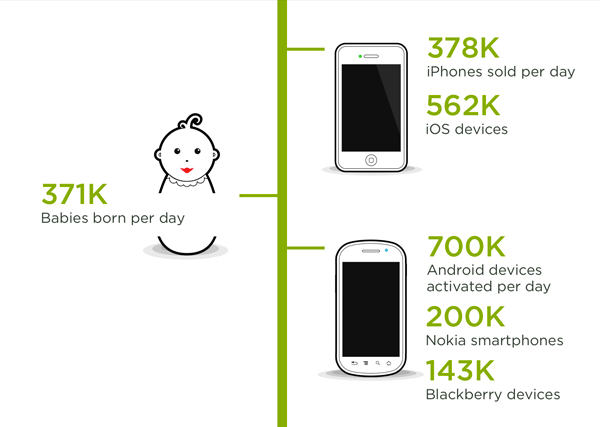
The End of 2012
The total of smartphones entering the World per day was about 3.6M devices again compared to the same 371 thousand births.

Hope you’ve got you multi-device design strategy in order.
Why Mobile Matters
When I initially proposed the idea of Mobile First over three years ago, there were a lot of skeptics. The situation today has a lot more people convinced that taking mobile seriously matters. But just in case some people remain unconvinced, here’s a really vivid way of explaining the situation.
Number of Mobile Devices

Every day 371,124 children are born across the World.
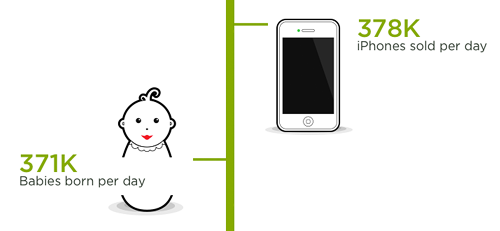
Every day 377,900 iPhones are sold across the World.

Every day 700,000 Android devices are activated across the World.

Looking at the total of iOS devices (iPhones plus iPads and iPod Touches) sold per day brings the total of Apple mobile devices sold per day to 562,000. Together with Android devices that’s 1.27M mobile devices sold or activated per day compared to 371,124 children born.
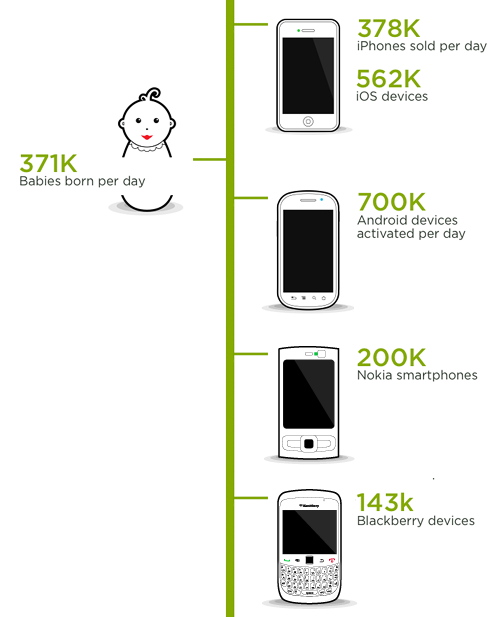
But there’s more. Nokia sold 200,000+ smartphones a day (and 958k feature phones). RIM sold 143,000 Blackberries a day at the end of 2011. This brings the total of smartphones entering the World per day to about 1.45M devices again compared to 317,124 births.
Share of Personal Computing
Clearly there’s a lot of mobile devices coming into the World. That’s having a huge impact on the personal computing market. Looking at data compiled by Asymco, the first 15 years of personal computing consisted of a few manufacturers trying to figure things out (Amiga, Atari, Apple).
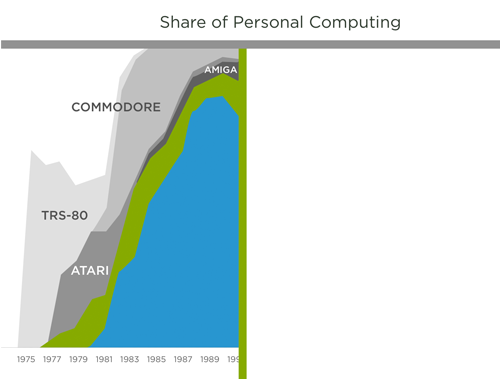
The next 15 years were completely dominated by Microsoft’s WinTel platform with Apple barely hanging on.
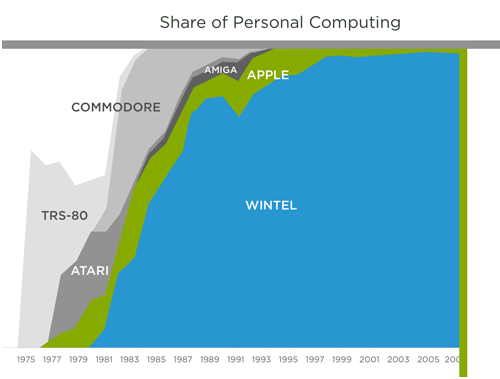
Fast forward to the past 3 years and you can see a huge shift underway. Apple and Android are eating into personal computing in a massive way. That’s because today’s mobile devices aren’t just phones they’re the most personal form of computer we have: always with us, always connected, and highly capable.
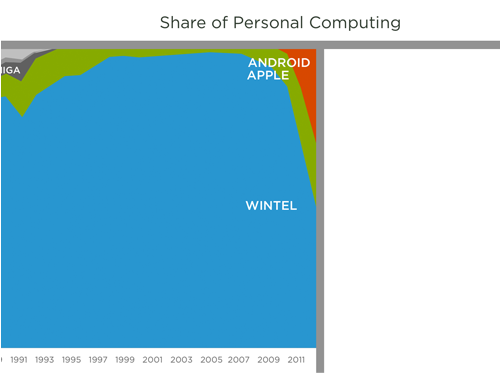
Real Opportunity
As mobile devices take over personal computing, a lot of opportunity is created for software companies and services. Consider mobile payments on PayPal. In 2009, mobile payments totaled $141 million. At the end of 2011, that number had grown to $4 billion. You read that right from $141 million to $4 billion over the course of three years.
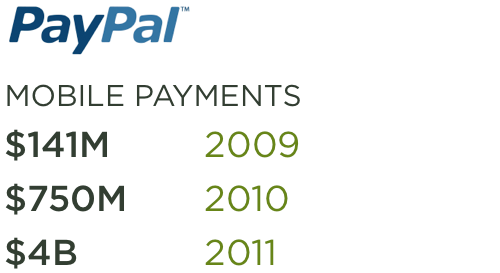
eBay has seen a similar trend. eBay reached $5 billion in mobile GMV (gross merchandise volume) in 2011, more than doubling 2010′s GMV of $2 billion. This was up from $600 million in 2009.
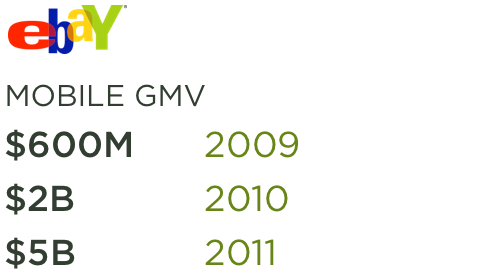
Hopefully this sample of data points helps some mobile skeptics see the opportunity we’re facing. If you need even more convincing check out my ongoing series of data posts for a deeper look at the mobile market and beyond.
10 Experimental User Interfaces
Minority Report. The sci-fi flick was released in cinemas over a decade ago, but viewers are still captivated by the idea of accessing and moving data with their hands.
The idea still feels like a pipe-dream however, given that many of us still work with a traditional keyboard and mouse/trackpad setup in our office and home. The dream of swiping through the air or talking to a personal assistant like Jarvis from Iron Man feels exactly that – a dream, but nothing more.
Many firms are exploring these ideas, however and pushing what’s possible with our present technological capabilities. The results are fascinating and often deviate from the input and interfaces that we’ve come to long for in Star Trek (holodeck please!)
These are useful, experimental platforms that will influence the way people engage and work with technology. Better yet, some of them are available right now.
Leap Motion
It’s refreshing to point or swipe at a screen and see content react accordingly. There’s an immediate connection of both action and reaction that clearly reflects how the user would interact with a physical object in the ‘real’ world.
Leap Motion is this and more. The device, announced last year, is unique because it’s tiny and unobtrusive. A tiny metallic bar sits between the keyboard and monitor, which anyone can then approach and start using simply by waving their hand.
It’s incredibly accurate, offering detailed handwriting, precision pinch-to-zoom and all sorts of intuitive hand gestures that are both natural and concise. No standing up or arm-flapping required. Just quick and effortless interaction.
MYO
A casual onlooker might not see the advantages of MYO straight-away. The user attached an inconspicuous armband, which is used to measure various muscle activity as they wave and point at the screen.
The clear advantage over Leap Motion is that it isn’t location-specific. Promotional videos have shown the user walking away from a desktop computer and then altering the volume on the other side of the room, simply by moving his wrist in a circular motion.
Professionals delivering a presentation can forego a remote and simply swipe two fingers in the air to move to the next slide. The use-cases are almost endless, although the clear limitation is that it’s following only one portion of the body. One arm, one control input.
Oculus Rift
The applications for hardware-enabled virtual reality experiences are mouth-watering. Being able to walk through a digitally rendered field and look left and right, at will, to see what’s around lends an entirely new level of depth and immersion. The opportunity to combine this with sound and touch feedback also hints at fully realized worlds for the user to explore.
Oculus Rift is a head-mounted virtual reality headset being developed by Oculus VR, a company that raised $2.4 million on Kickstarter to develop and release the product to the public.
It’s still early days and in truth, the hardware is far from perfect. Yet the promise of building an immersive, one-to-one first person perspective has been realized and that’s fascinating in its own right. These futuristic goggles are being aimed at gamers in particular, but the opportunity to use it for personal computing is also plain to see.
Google Glass
From the moment Google formally unveiled Glass at its I/O developer conference in 2012, everyone couldn’t stop talking about it. The idea of wearing a pair of perfectly normal glasses, fitted with a powerful computer and head-mounted display seemed impossible.
Yet Google seems to have nailed it. Even better, the company plans to release the device to the public in the not-so-distant future. It offers a point-of-view camera capable of shooting photos and 720p HD video, as well as a small touchpad for navigating menus and the onscreen interface.
Glass appears to be the epiphany of mobile computing. The device can be taken anywhere and is accessible at anytime. It’s alo small and relatively inconspicuous, which means the device is out-of-the-way when the user wants to focus on their surroundings.
Kinect, version 2.0
Motion controls have had a tough old-time in the video game industry. When the Nintendo Wii was launched, it heralded a new age of remote waggling in the living room. Third-party developers struggled to take advantage of the technology in a meaningful way, however and had to compete with counter-offers from both Microsoft and Sony.
Kinect, a motion sensor that uses an infrared projector and camera to analyze the player’s movements, was a novel idea when it launched in 2010. The ability to track the entire body produced a couple of memorable experiences such as Dance Central and Child of Eden, but it suffered from frequent accuracy issues.
Microsoft unveiled the next version of Kinect simultaneously with the Xbox One, its new video game console launching this year. The resolution has been upped to 1080p, and an ultra wide-angle lens means that it can be used in the even the smallest apartments.
The kicker, however, is that like the original Kinect, Microsoft will also belaunching it for Windows next year. The previous version was embraced by the modding community and resulted in a number of innovative and off-the-wall experiments. Even better hardware should produce more of the same.
G-Speak
Still looking to re-enact Minority Report? G-speak, built by Oblong Industries, is the closest working product to realizing that dream. Users don a pair of specialized gloves that can then be used to interact with data through various arm movements and hand gestures.
It integrates with large screens and multiple surfaces, encouraging large-scale collaborative projects and a more direct approach to problem-solving.
The gloves themselves are a little unattractive, but it means that anyone can use the system without re-calibrating the hardware. It’s a little way off Tony Stark’s personal lab in Iron Man 3, but the groundwork is there to realize this pioneering form of interaction.
Google Talking Shoe
At South by Southwest (SXSW) 2013, Google showed up with an interactive playground and a pair of talking sneakers, nicknamed henceforth as ‘The Talking Shoe’.
It’s not a consumer product – which is probably a good choice – but it does highlight the sort of wacky, off the wall thinking that even high-profile companies such as Google are coming up with.
This high-tech pair of trainers comes equipped with a pressure sensor, accelerometer and gyroscope, which tracks the user’s movements to deliver progress reports, advice and general abuse, such as: “Sitting down on the job, are we?”
It’s all a bit silly, but isn’t that what experimental projects are all about?
Microsoft: Live, Work, Play
Microsoft has built what it likes to call an ‘Envisioning Center’, where employees develop and prototype ideas that could be used by consumers in the next five to ten years. Back in March, the company released a promotional video offering a glimpse of the future, which involved an awful lot of touchscreens that are connected with one another.
Forget wallpaper, as some of these screens will take up the entire wall in your living room, kitchen or bedroom. Users are seen clamping a Surface tablet into a large desk – similar to what an architect might use – which is equipped with a huge touchscreen for cross-platform creation.
The same device, but fitted in the kitchen, expands on the concept of pinning artwork and notes to the refrigerator door, enabling users to bring up photos and word documents created on any device around the home.
Each wall screen is also fitted with a Kinect-style webcam for analyzing objects in the room. One demonstration has the user raising an ingredient and asking what he should cook with it; cue a series of recipes and step-by-step instructions, displayed on a kitchen table-top.
Touch screen devices are nothing new, but the idea of seamlessly combining them into one unified surface, alongside huge mounted wall screens, could easily change users’ behavior and workflow around the house.
Pebble
Remember those amazing wristwatches that James Bond used to wear? The Rolex with a small laser beam in Never Say Never Again, or the Seiko Quartz watch with a built-in telex for sending mission critical messages? Well, unfortunately those don’t exist.
What we do have, however, is Pebble. It’s the first truly successful smartwatch, combining expansive functionality with attractive, robust hardware. Funded via Kickstarter – and breaking a few records in the process – Pebble offers a small e-ink display that communicates with an Android or iOS device over Bluetooth.
The Pebble comes with a few apps pre-installed, but the company’s open SDK means that anyone should be able to push the platform forward with new and interesting software.
Voice
One of the more interesting trends in the last few years has been the development of voice recognition software for various hardware ecosystems. Siri is one of the most notable, having been launched by Apple in October 2011 as a personal assistant for the iPhone and iPad. Users can use everyday words and phrases to execute tasks for a number of different applications, including reminders, email and weather.
Google has introduced its own interpretation as part of its standalone Google Search app for iOS and Android. It’s fast, accurate and intuitive, to the point where Google has also decided to introduce it as part of the Chrome web browser on the desktop.
Barking commands at a nearby smartphone or tablet can feel a little jarring at first, but the applications are numerous. Being able to prepare a dish in the kitchen and ask for the next instruction, for instance, without washing your hands and swiping across the screen is rather helpful.
The aforementioned Kinect controller is also starting to use this technology for the living room; users will be able to simply say “Xbox, ESPN” to switchover to a live sports game without rooting around for the controller.
Touch, speech, gestures. It’s a brave new world
The emergence of all these platforms points to a future where a traditional keyboard and mouse might be the exception, rather than the rule, for interacting with technology.
That’s not to say we’ll stop using laptops in the next 12 months, or we’ll all be shouting at our monitors in the office for nine hours straight, but there’s a clear opportunity to try new, experimental ideas with our current rate of technological advancements.
The future of user interface is therefore bright, unknown and also pretty darn exciting.
- interactive
- interaction
- installation
- design
- led
- light
- art
- technology
- projectionmapping
- projectmapping
- robotics
- ui
- mobile
- projection
- interactivedesign
- lightdesign
- apple
- web
- 3d
- ux
- userinterface
- lightart
- robot
- artinstallation
- touchscreen
- application
- app
- webdesign
- touch
- motion
- responsive
- adobe
- multitouch
- future
- robots
- drone
- photoshop
- productdesign
- ledinstallation
- lightsculpture
- video
- user experience
- iphone
- creative
- interactivelight
- digitalart
- motiondesign
- ar
- 3dprinting
- responsivedesign
- augmentedreality
- drones
- kinetic
- data
- development
- kinect
- microsoft
- display
- immersive
- process
- painting
- timelapse
- dronerobotics
- 3dprojection
- ios
- vr
- virtualreality
- earth
- ai
- device
- user interface
- engineering
- laser
- lightpainting
- kineticsculpture
- lightinstallation
- touchinstallation
- animation
- programmableleds
- graffiti
- interactions
- neon
- performance
- leapmotion
- watch
- mobiledesign
- pixel
- environment
- exoskeleton
- interactiveenvironment
- sound
- lcd
- social
- leds
- lukew
- artlight
- patterns
- internet
- carui
- November 2011 128
- December 2011 65
- January 2012 25
- February 2012 27
- March 2012 33
- April 2012 31
- May 2012 16
- June 2012 32
- July 2012 20
- August 2012 37
- September 2012 24
- October 2012 34
- November 2012 31
- December 2012 6
- January 2013 21
- February 2013 11
- March 2013 10
- April 2013 35
- May 2013 45
- June 2013 10
- July 2013 49
- August 2013 33
- September 2013 40
- October 2013 57
- November 2013 31
- December 2013 28
- January 2014 86
- February 2014 49
- March 2014 24
- April 2014 40
- May 2014 6
- June 2014 9
- July 2014 1
- August 2014 34
- September 2014 30
- October 2014 45
- November 2014 21
- December 2014 6
- January 2015 5
- February 2015 17
- March 2015 18
- April 2015 14
- May 2015 1
- June 2015 10
- July 2015 4
- August 2015 1
- October 2015 11
- March 2016 4
- December 2016 18
- September 2017 6
- October 2017 13
- November 2017 5
- June 2018 8
- July 2018 2
- November 2018 7
- February 2019 8
- March 2019 6
- July 2019 1
- August 2019 1
- October 2019 1
- July 2020 5
- November 2020 9
- December 2020 1
- January 2021 1
- April 2021 1
- May 2021 9
- June 2021 3
- August 2022 3
- May 2023 2
- September 2023 1
- May 2025 6

